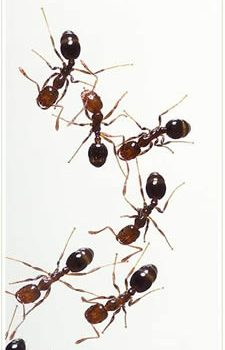Red imported fire ants are 1/8 inch to 1/4 inch (3-6 mm) long and reddish brown. These ants are very widespread and very much a pest here in Charlotte and the metro area. Fire ants look a lot like ordinary ants that you may see in your yard but are probably best distinguished by their aggressive behavior and characteristic mound building shaped nests. They will forage along edges of sidewalks and street curbs in order to get to where they want to go. When their nests are disrupted, fire ants swarm out to bite whatever hit their home – pets, kids, or lawn equipment. If unattended, they can enter buildings, and sometimes forage indoors for food and moisture. They are a nuisance and can threaten sleeping or bedridden individuals and pets.
 Not only because of the physical pain they can inflict, but because their mound-building activity can damage plant roots, pop up in your lawn shortly after a summer rain. It is not uncommon for several fire ant mounds to appear suddenly in a suburban yard seemingly overnight. Their stings inflict both pain and the formation of white pustules that appear several days after the sting. RIFA can be as far as six feet underground; otherwise, some queens may simply move a short distance away and quickly re-establish the colony.
Not only because of the physical pain they can inflict, but because their mound-building activity can damage plant roots, pop up in your lawn shortly after a summer rain. It is not uncommon for several fire ant mounds to appear suddenly in a suburban yard seemingly overnight. Their stings inflict both pain and the formation of white pustules that appear several days after the sting. RIFA can be as far as six feet underground; otherwise, some queens may simply move a short distance away and quickly re-establish the colony.
Red imported fire ants are extremely resilient and have adapted to contend with both flooding and drought conditions. If the ants sense increased water levels in their nests, they will come together and form a huge ball or raft that is able to float on the water, with the workers on the outside and the queen inside. Once the ball hits a tree or other stationary object, the ants swarm onto it and wait for the water levels to recede. To contend with drought conditions, their nest structure includes a network of underground foraging tunnels that extends down to the water table. Also, despite the fact that they do not hibernate during the winter, colonies can survive cold conditions as low as 16 °F (-9 °C). Occasionally they feed on vegetable plants in home gardens. The worst damage usually occurs during hot, dry weather when they invade flowerbeds while seeking warmth and moisture. They have been known to short out and damage air conditioner condenser units and other types of electric devices around homes and buildings.

